My highest converting source of paid traffic has always been Google Product Listing Ads. And they’re the highest converting source of traffic for a reason…When set-up properly, you can show your products to a laser-targeted audience.
When someone searches on Google for a:
- brand name
- product name
- and/or SKU#
… you can get your product image, product name and price to appear right on the first page of Google.
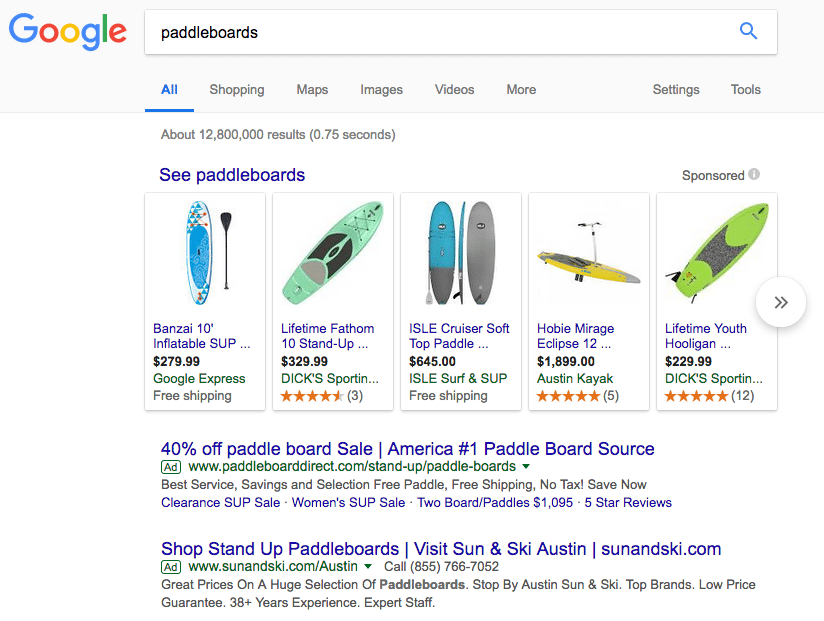
Think about it… the people who are clicking your ads have used buyer keywords. They’ve already seen your product image AND product price. They know they’re going to be sold to and that’s exactly what they want!
Google PLAs (Product Listing Ads) are the easiest way to build a successful drop shipping store.
That’s why I have Michael Erickson of Search Scientists, and creator of our new Google Ads for eCommerce course, here to break down a 6-month game plan. His plan will have get your drop ship store on the right track and making $30K/mo in sales within six months!
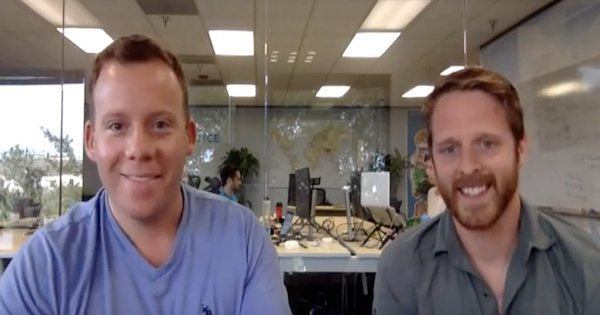
Myself and Michael in a previously recorded video discussing paid traffic strategy for drop shipping stores.
The Problem With Most Online Marketing Education For PPC
It’s very difficult to gain traction with online marketing when starting eCommerce stores. It’s difficult because we’re under attack.
When it comes to online marketing education, we’re getting bombarded.
It’s a situation I see time and time again with people new to online marketing. We get overloaded with a flurry of tips & tricks.
Open up your Twitter feed. You’ll see a barrage of different paid traffic tips & tricks that will push and pull you in so many different directions. With this information overload, you may never gain the traction you need to build profitable paid traffic campaigns. If you constantly jump from one trend to another, you’ll never build up the understanding for what a strong PPC-Plan looks like for your business.
When you’re first starting out you need a framework, a game plan, and a 20,000 foot view of the landscape. Then you can dig into the tips & tricks to make each stage of the paid traffic game plan more effective.
By reading this post, you’ll be given a high-level overview of how I believe most starting eCommerce stores can hit $30K/mo in revenue just from a few core paid traffic campaigns. We’ll tap into both search & social channels from Google Ads to Facebook Ads.
A 6-Month Paid Traffic Plan To Your eCommerce Store’s First $30K/mo
I’m going to give you a 6-month outline for your new drop shipping store. By the end of it, you’ll have built up a strong paid traffic program that captures new customers from the top to bottom of your sales funnel.
Month 1: Master Your Economics: Find Your Minimum ROAS
We’ve all seen it when watching Shark Tank. The entrepreneurs are pitching their business. Mark Cuban asks them about the cost of goods sold and margins, or cost to acquire a customer. The entrepreneur crumbles, they stall. Mark Cuban says….”I’m out”. The entrepreneur didn’t know their numbers.
I can’t tell you how many times I’ve spoken to smart, accomplished people who just didn’t know their paid traffic goals.
We’re going to fix this here.
There are three pieces to the paid traffic economic equation:
ROAS - Revenue From Ads Over Ad Spend
Costs - Cost Of Goods Sold + Ad Spend
Profit - Total Revenue – Costs
What is ROAS?
ROAS (Return On Ad Spend or Revenue Over Ad Spend) is a simple calculation. Revenue from advertising / Ad Spend.
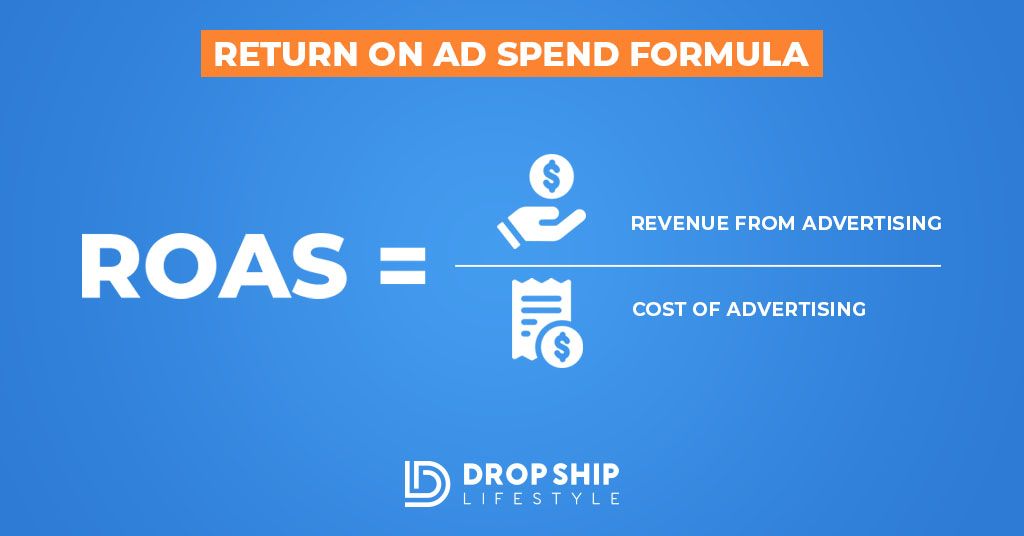
You will use ROAS to describe every element in every campaign you launch. What’s the ROAS of this campaign/keyword/day/month/gender/age/etc? We use ROAS as a way to describe the simple idea: How much revenue did we generate compared to how much our ads cost?
First, we’ll want to establish and brainstorm our minimum acceptable ROAS. In other words: at what point do we start making profit?
We want to find our minimum acceptable ROAS. Then, make sure every paid traffic campaign is above that lower limit.
You’ll want to create a chart just like the one I created below based on your own COGS (Cost Of Goods Sold).
You can see in the example above, that anything over 2x ROAS is where I start making profit. Anything below 2x is where I’m losing money.
Knowing what you are aiming for is vitally important, which is why I’m giving you a few weeks to plan out your financials targets for paid traffic.
Month 2-3: Launch Google & Bing Ads Search Based Campaigns
For most eCommerce stores, search based campaigns are going to be the easiest place to get started. Someone actively searching for a product on these platforms is more likely to purchase than on Facebook Ads.
Note:
I’ve seen all kinds of things in my career in paid traffic. While it’s true that certain kinds of stores with very unique products (i.e. no one is searching for them because they don’t know they exist) will gain traction faster on social traffic, this post is meant for drop shippers, who usually aren’t manufacturing their own products.
First Campaigns To Launch: Shopping Campaigns (Product Listing Ads / PLA’s)
Shopping campaigns are typically the easiest, fastest way to start generating revenue for a drop ship store.
Shopping ads are fantastic for drop ship stores because:
- Users see the price
- Users see the image
- Google frames the ads with text: “Shop for keyword”
The magic of those three points above is that only people who are commercially minded will click on the ads. This means your costs will be low, your conversion rate will be high, and you should be able to hit your target ROAS with these ad types.
Grab Your Most Profitable Terms from PLA’s and Run Search Text Ads
Most people get overwhelmed when it comes to Search Text Ads. They think they need to do 100’s of hours of keyword research. While that helps, you can launch your Search Text Ads by only looking in one spot.
Look at the search query report for your shopping ads. Take your most profitable terms. Run Search Text Ads to those keywords.
Essentially, you’re increasing your visibility for your profitable terms from PLA’s. You’ll be boxing out competition and increasing your sales volume.
Expand To Audience Based Search Targeting
Our last campaign type on Google & Bing Ads is going to be audience based campaigns
The first audience to use is simple: your retargeting audience. Your retargeting audience for search will consist of everyone who has previously visited your website. We’re going to use retargeting on search to bring back high converting traffic.
Why bother creating a special campaign just for this audience?
Well if your site is like most drop ship stores, you have a much higher conversion rate for people who have visited multiple times vs. single-session users. You can find this out in Google Analytics. Here’s what one of my client’s sites look like:
The conversion rate for multi-session users was much higher than single session users. By retargeting on search, you can capture more of this high converting traffic.
Setting up retargeting on search ads is a quick process, and can be done inside your Google Ads account back-end.
From there, you can expand to demographic based search campaigns.
Think only Facebook knows your preferences based on the Facebook posts you like and pages you follow? Think again. Google knows a ton about your preferences.
Let’s do an experiment. Head over to: google.com/ads/preferences
You’ll see a list of characteristics Google knows about you based off your searching, YouTube shopping history, and more.
Here’s an example of what you’ll see:
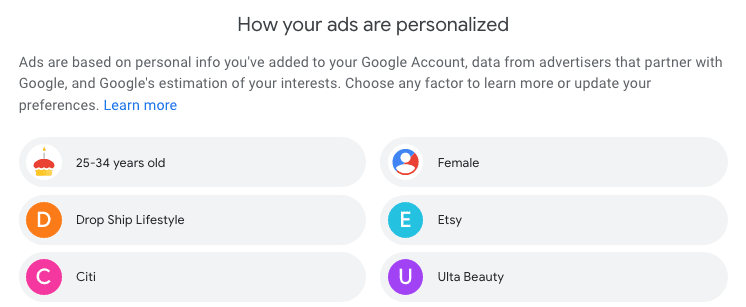
Now while you can’t target search-based campaigns with that interest level targeting, you can create demographic based campaigns on search. If you know the age & gender of your best customers, use it to your advantage.
Google recently added the ability to apply the interests to your search campaigns, so it’s important to be aware that Google has this information.
Month 4: Launch DPA’s on Facebook (Dynamic Product Ads)
By month four, we’re going to unleash a truly powerful campaign type: dynamic retargeting. On Facebook, these are known as Dynamic Product Ads.
Essentially, with a little piece of code, you can have your users:
- View product A on your website
- Then later that day, view product A in an ad on FB.
Setting up Dynamic Product Ads has become very easy thanks to Shopify’s integration with the Facebook Pixel.
Once you launch your DPA’s, you’ll notice that your conversion rate should rise. It’s a great introduction into the social network’s paid traffic program.
Month 5: Cold Traffic Lookalikes To Pre-Sales Engagement
Up until this point, every campaign I laid out involved people who have searched for our products. We’re now going to enter the world of targeting people who are in our demographic, but haven’t searched for anything.
Social paid traffic can be a dangerous place for eCommerce stores. You simply can’t treat cold traffic like normal, actively searching traffic.
The way we’re going to enter this arena is by first targeting lookalikes on Facebook. Essentially it works like this:
- You show Facebook your website traffic using the Facebook Pixel you have installed on your site.
- Facebook looks at those users and determines that these users are 30-50 years old, love the color green, and the New York Jets.
- Facebook then goes and finds other people who have those similar traits.
Starting with lookalikes allows you to find users similar to the audience that is already interacting with your drop shipping site.
While these users have similar demographics to the users already on your site, that doesn’t necessarily mean you should treat them the same way. Remember, everyone up until this point was search-based. These people are simply demographic-based only.
What the most successful eCommerce stores do is have some sort of pre-sales information-based engagement ad that they serve to this cold traffic. Then, they follow up with a commercial retargeting ad.
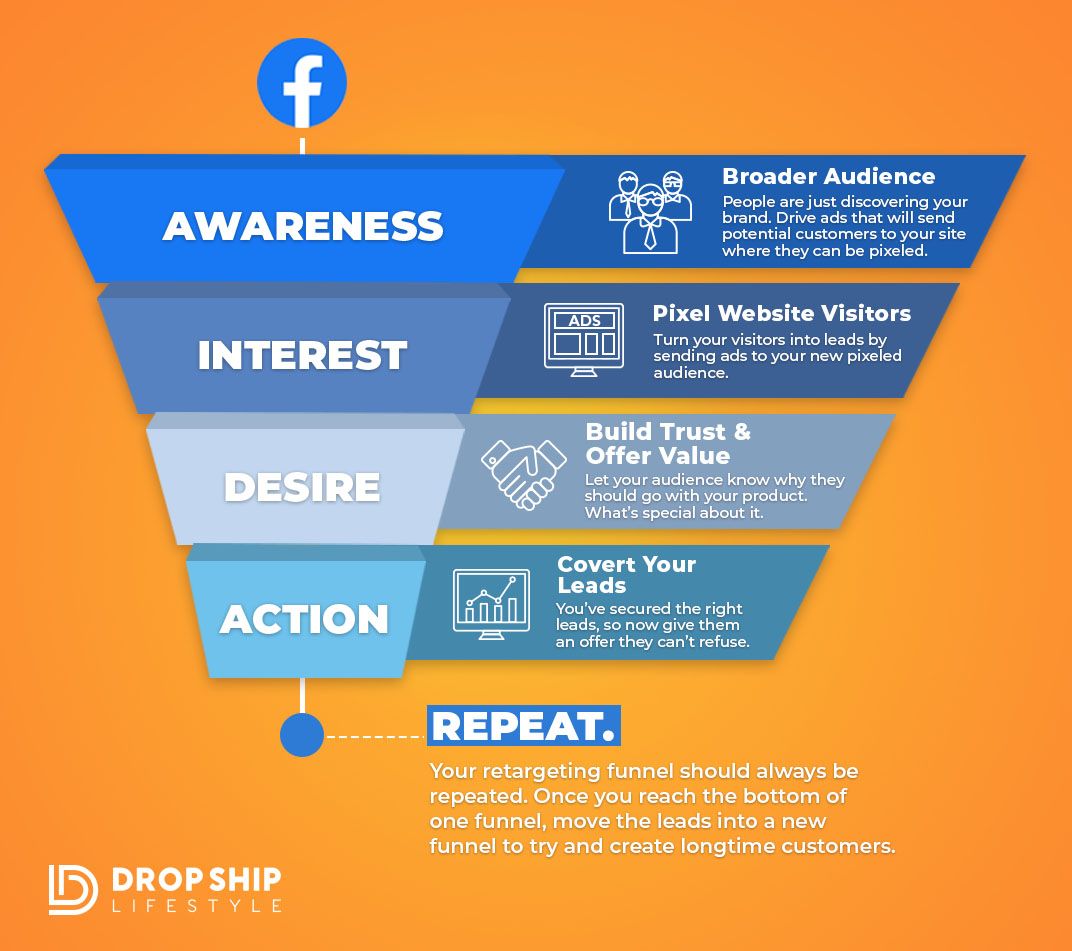
Facebook Retargeting Paid Traffic Example:
- Perhaps you sell cordless vacuums that help people vacuum their home easier.
- Your cold-traffic lookalike pre-sales engagement is a video: “Can you really vacuum your entire house in under 5 minutes?”
- The video isn’t trying to get the sale, but the focus is to build a positive interaction. You’re simply making them aware and interested that there is a cordless vacuum out there, and that you can vacuum faster because of it.
- You then retarget the people that watched 25% of your video with a commercial ad (coupon, promo etc..).
- From there, the people that view the product will slide into your DPA campaign to seal the deal and get the sale.
You’ve just created a simple, powerful sales funnel. You’re now doing big things.
Getting to $30K/mo in Revenue
I’m a big believer of mapping out our goals, and then laying down the plan to get there.
I believe that any viable eCommerce store can get to $30K/mo in revenue just with the campaigns described in this post. Here’s how it would work:
- Month 1: Determine minimum ROAS. Let’s say it’s 6x for you.
- Month 2: Launch PLA’s on Ad and Bing Ads: Spend 3k/mo at 6x ROAS, and you’re up to 18k/mo in revenue
- Month 3: Launch Search & Audience Based Search Campaigns on Google Ads & Bing Ads: Spend 2k/mo at 6x ROAS and you’re up to 12k/mo in revenue.
- Month 4-5: Launch DPA and Lookalike Campaigns on Facebook: Spend 2k/mo at 6x ROAS and you’ve added another 12k/mo in revenue.
With these numbers, you should be able to hit your monthly recurring revenue goals in under 6 months.
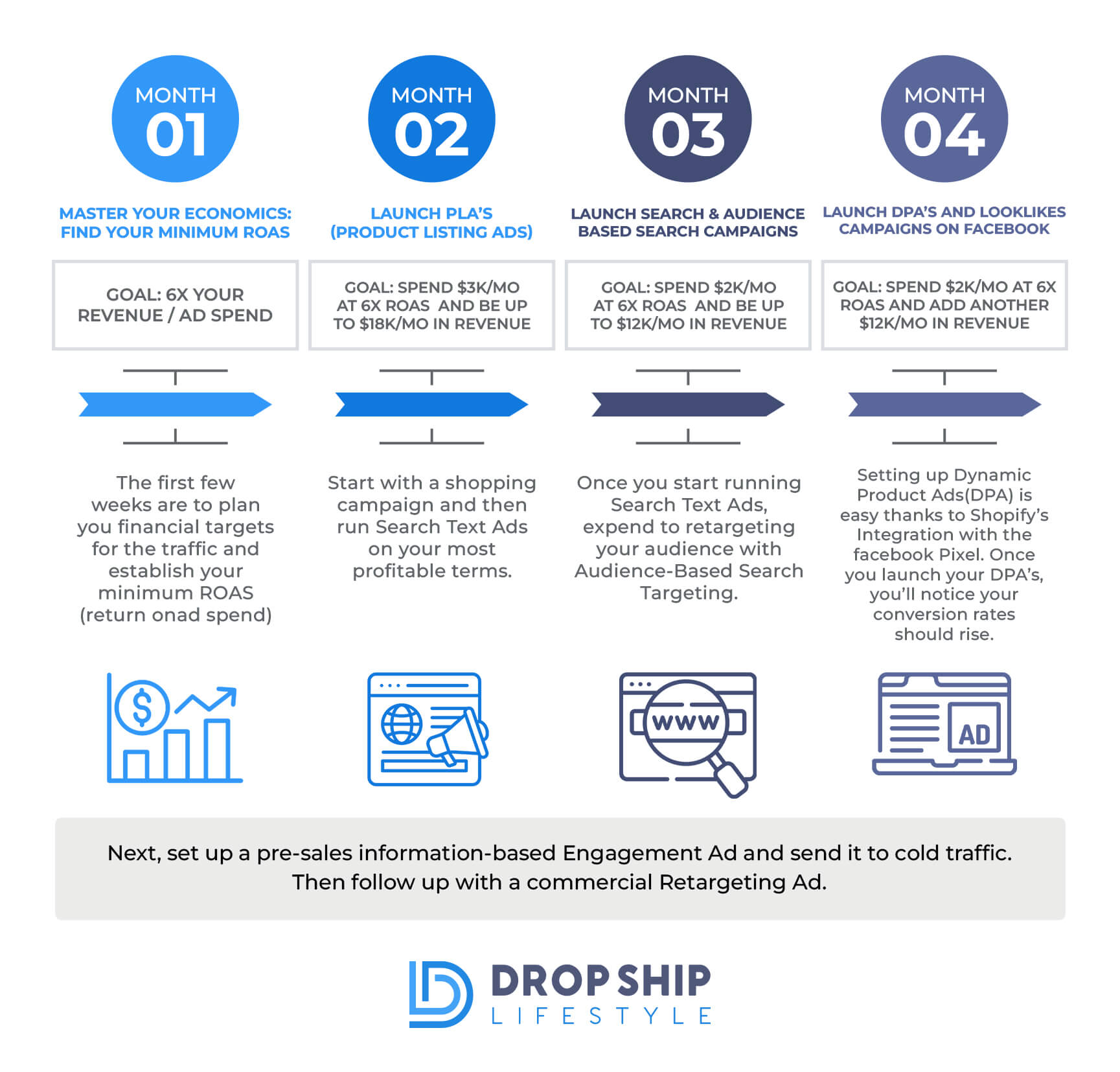
Now that you have a paid traffic framework, you can go out and start reading tips & tricks for those campaign types without being overwhelmed or distracted.
This article has been brought to you by Michael Erickson from SearchScientists. Interested to talk more about the 6-month plan? Drop me a line anytime!
There is plenty of money to be made in drop shipping. Drop shipping is one of the easiest, low maintenance, eCommerce businesses that exists. You just need to know how to get people to your site… and this is where people fail. But you don’t have to fail like them. Actually, we want you to succeed.

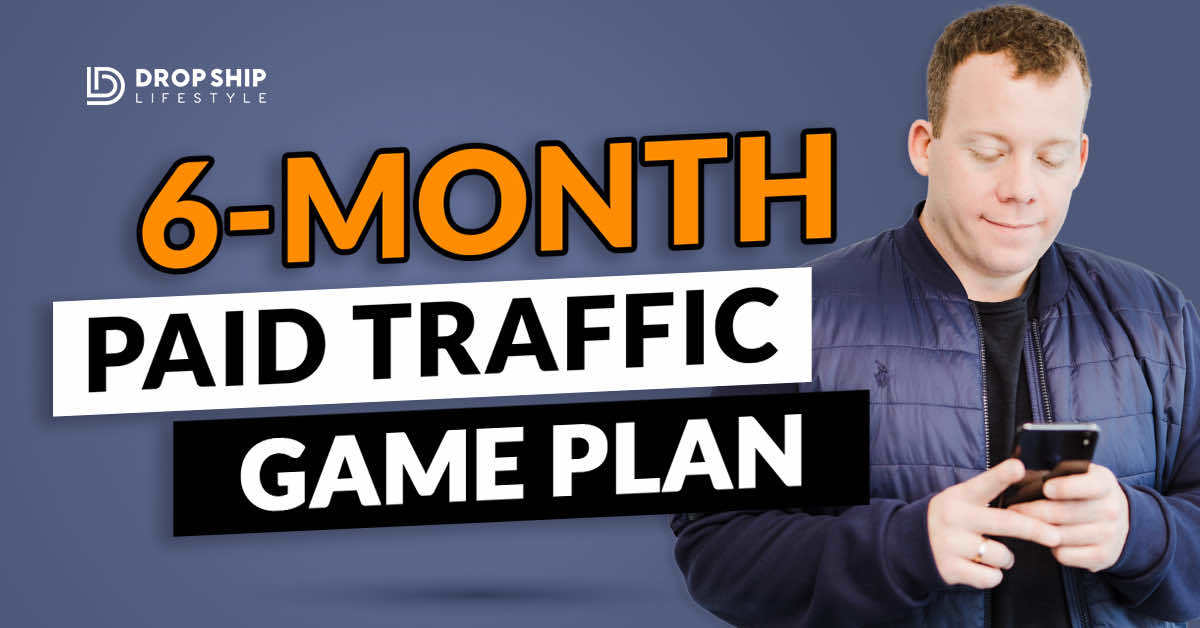

Hey Everyone,
As many of you already know I created Drop Ship Lifestyle after selling a network of eCommerce stores and then trying to find a community of other store owners to network with… What I found was a bunch of scammers who promised newbies they would get rich quick by following their push-button systems!
This led me to create a new community along with an online training program that shares how to build a REAL online business.
I’d love to hear what you think… it’s a 2.5-hour training designed to help you drop ship profitably… all for free.
Be sure to click here to check it out and send me your feedback!
If you go through the “How To Start & Grow A Hyper-Profitable Online Store” webinar and still have questions just contact me and I will help you out.
What’s the profit margin% after revenue?
We aim for at least 30% net profit.
Please, how do I get this documents?
You can email support[at]drposhiplifestyle.com
PPC can seem SO INTIMIDATING when you first approach it. Hopefully, this document helps keeps everything in perspective.
you’re talking 3k in the first month for ads….that seems mighty high for someone just getting started.
You can start smaller, but if you do – start with a smaller product list. The goal is to get a significant number of clicks towards what you believe to you be your top products when you start out. If you have a budget less than 100/day for 100s of products, it will take you FOREVER to get good data!
So try to get at least 100 clicks for your top products. With a 1% conversion rate, that should be enough to start seeing conversions.
What’s the ideal minimum?
There really isn’t a minimum… but we typically start new stores with a budget of around $30/day.
We then increase our ad spend as we start getting sales and seeing which ads are working, and which ads are not profitable.
Great post! Breaking it down like that, month-by-month, makes it so much easier to tackle 🙂
Thanks Michael. Looking forward to finalising my store to get started with this. Am I correct in thinking that PLA’s will drive traffic seeking the best price? ie they have found what they like somewhere by browsing and then search for brand, model etc?
EVERYBODY searching online is looking for the best price 😀
Yes, in general, Shopping Ads (PLA’s) will be higher conversion-intent.